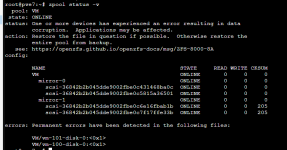Good morning everyone,
I could use your help in designing the best setup for my current Proxmox environment.
Here's the current scenario:
However, I'm facing issues:
Given this situation, what would be the best approach to using ZFS in this setup? Should I reconsider how I'm allocating virtual disks from the pool, or is it more likely a hardware or configuration issue with ZFS?
Any suggestions or insights would be greatly appreciated.
Thank you in advance!
I could use your help in designing the best setup for my current Proxmox environment.
Here's the current scenario:
- I'm running Proxmox VE with 4 x 1TB disks.
- I've created a ZFS pool using RAID10, resulting in a pool named VMS with ~2TB of usable space.
- I'm virtualizing a Proxmox Backup Server (PBS) inside this PVE.
- I’d like to use the VMS pool to allocate virtual disks for PBS and also for other virtual machines, such as one that provides Samba file sharing.
However, I'm facing issues:
- The PBS virtual disk stored in the VMS pool is showing errors.
- Another VM using the same pool (Samba server) is reporting I/O errors.
- The zpool status command reports the VMS pool is degraded.
Given this situation, what would be the best approach to using ZFS in this setup? Should I reconsider how I'm allocating virtual disks from the pool, or is it more likely a hardware or configuration issue with ZFS?
Any suggestions or insights would be greatly appreciated.
Thank you in advance!






